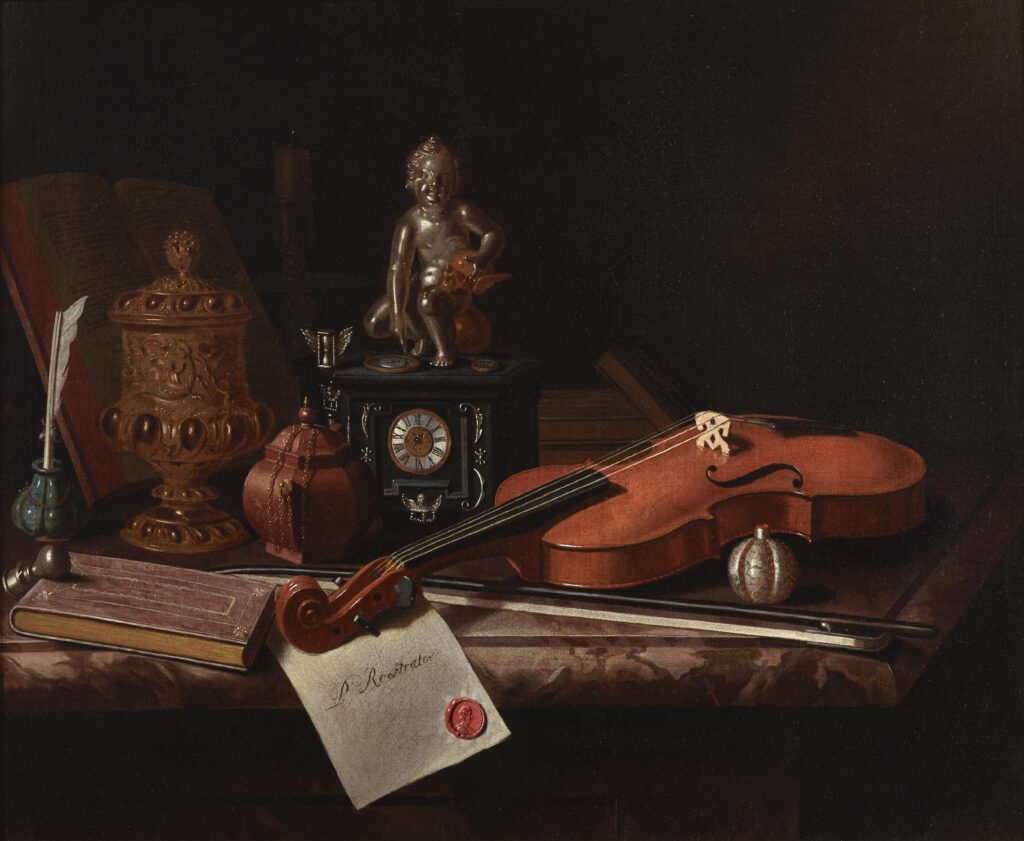Pieter Gerritsz. van Roestraten
1630 - 1700
A Still Life with a Violin, a Yixing Teapot, a Silver Clock and other Objects


Medium:
Oil on Canvas
Category:
Dimensions:
59(h) x 72(w) cms
Framed Dimensions:
79(h) x 92(w) cms
Signed:
signed on the parchment: 'P Roestraten'
Essay:
A Dutch painter of still-life and genre scenes, Pieter Gerritsz. van Roestraten was apprenticed to Frans Hals in Haarlem until 1651 and married his former master’s daughter Adriaentje in 1654. Figurative works by Roestraten are rare, but he is known to have emulated Hals's style of portraiture and some early works depict genre scenes of peasant life influenced by Jan Steen and Gerard ter Borch.
Roestraten had moved to London by 1666 and he quickly fell in among the community of Dutch and English artists including Sir Peter Lely who introduced him to King Charles II. In England, Roestraten concentrated his efforts on still lifes, developing a new kind of still life not before seen in the country which often included precious objects like china, plate, glass, goblets, and silver and ivory tankards. These works were inspired by the pronkstilleven being produced at that time in the Netherlands which had not yet arrived in England. They allowed Roestraten to display his remarkable skill at rendering different textures, particularly that of silver for which he was much praised. His works were eagerly collected by his English patrons and can today be found in the Royal Collections at Buckingham Palace and Hampton Court.
Teapots and Chinese tea ware are one of the most common motifs in Roestraten’s still lifes. The teapot in the present picture appears to be a Yixing teapot. Made from the renown red zisha clay of the region, this object would have been imported by the Dutch from China at great cost, as would the tea, the consumption of which was rapidly growing in fashion in Europe in the latter half of the 17th century. Charles II’s wife, Catherine of Braganza, is often credited with popularising tea in England, and the drink was soon associated with social distinction and polite culture. The gilt-metal mounts were likely added in Europe, and an identical teapot appears in a work by Roestraten in the collection of Sheffield Museum.
Many objects in Roestraten’s paintings recur throughout his oeuvre suggesting that at least some may have belonged to the artist himself. Violins, pomanders, and gold, silver, and porcelain pots and urns are quite common. The elaborate silver and mahogany clock with a cherub and winged hourglass is significantly rarer and is a particularly curious and beautiful object. It has been suggested it might be a lost work by the great Italian sculptor Francesco Fanelli. Roestraten skilfully combines these objects into a single composition to create a medley of pleasing textures and associations with luxury and the exotic.
According to Hellier family legend, the violin seen in Roestraten’s painting is said to be the eponymous Hellier Stradivarius, which is now in the care of the Stradivari Foundation in Cremona. However, we are reliably informed by string instrument expert Tom Woods that the depicted violin, with its noticeably arching front and back, is more reminiscent of instruments produced in the style made popular by the famous Austrian violin maker Jacob Stainer (circa 1617–1683). Stainer’s violins, produced from the 1630s, were held in the highest esteem and influenced many other European schools of violin production as late as 1800. However, towards the 1840s his style of violin making had become almost extinct, eclipsed by that of another master luthier, Antonio Stradivari from Cremona (1644–1737).
Provenance:
The Hellier Collection, The Wodehouse, Wombourne, Staffordshire